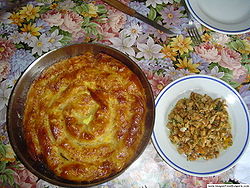
Eastern European cuisine
Encyclopedia


Cuisine
Cuisine is a characteristic style of cooking practices and traditions, often associated with a specific culture. Cuisines are often named after the geographic areas or regions that they originate from...
of Eastern Europe
Eastern Europe
Eastern Europe is the eastern part of Europe. The term has widely disparate geopolitical, geographical, cultural and socioeconomic readings, which makes it highly context-dependent and even volatile, and there are "almost as many definitions of Eastern Europe as there are scholars of the region"...
.
The cuisine
Cuisine
Cuisine is a characteristic style of cooking practices and traditions, often associated with a specific culture. Cuisines are often named after the geographic areas or regions that they originate from...
of a country is strongly influenced by its climate
Climate
Climate encompasses the statistics of temperature, humidity, atmospheric pressure, wind, rainfall, atmospheric particle count and other meteorological elemental measurements in a given region over long periods...
. For example, eastern German cuisine
German cuisine
German cuisine is a style of cooking derived from the nation of Germany. It has evolved as a national cuisine through centuries of social and political change with variations from region to region. The southern regions of Germany, including Bavaria and neighbouring Swabia, share many dishes....
, Polish cuisine
Polish cuisine
Polish cuisine is a style of cooking and food preparation originating from Poland. It has evolved over the centuries due to historical circumstances. Polish national cuisine shares some similarities with other Central European and Eastern European traditions as well as French and Italian...
and Russian cuisine
Russian cuisine
Russian cuisine is diverse, as Russia is the largest country in the world. Russian cuisine derives its varied character from the vast and multi-cultural expanse of Russia. Its foundations were laid by the peasant food of the rural population in an often harsh climate, with a combination of...
show many similarities, yet differ considerably from the cuisines of the Balkan peninsula.
See also
Armenian cuisineArmenian cuisine
Armenian cuisine includes the foods and cooking techniques of the Armenian people, the Armenian diaspora and traditional Armenian foods and dishes. The cuisine reflects the history and geography where Armenians have lived as well as incorporating outside influences...
Belarusian cuisine
Belarusian cuisine
Belarusian cuisine shares the same roots with cuisines of other Eastern and Northern European countries, basing predominantly on meat and various vegetables typical for the region.-History:...
Bulgarian cuisine
Bulgarian cuisine
Bulgarian cuisine is a representative of the cuisine of Southeastern Europe. Essentially South Slavic, it shares characteristics with other Balkans cuisines...
Czech cuisine
Czech cuisine
Czech cuisine has both influenced and been influenced by the cuisines of surrounding countries. Many of the fine cakes and pastries that are popular in Central Europe originated in the Czech lands. Czech cuisine is marked by a strong emphasis on meat dishes. Pork is quite common, and beef and...
Georgian cuisine Hungarian cuisine Lithuanian cuisine
Lithuanian cuisine
Lithuanian cuisine features the products suited to the cool and moist northern climate of Lithuania: barley, potatoes, rye, beets, greens, berries, and mushrooms are locally grown, and dairy products are one of its specialities...
Moldovan cuisine Polish cuisine
Polish cuisine
Polish cuisine is a style of cooking and food preparation originating from Poland. It has evolved over the centuries due to historical circumstances. Polish national cuisine shares some similarities with other Central European and Eastern European traditions as well as French and Italian...
Romanian cuisine
Romanian cuisine
Romanian cuisine is a diverse blend of different dishes from several traditions with which it has come into contact, but it also maintains its own character...
Russian cuisine
Russian cuisine
Russian cuisine is diverse, as Russia is the largest country in the world. Russian cuisine derives its varied character from the vast and multi-cultural expanse of Russia. Its foundations were laid by the peasant food of the rural population in an often harsh climate, with a combination of...
Slovak cuisine
Slovak cuisine
Slovak cuisine varies slightly, though sometimes dramatically, from region to region. It was influenced by the traditional cuisine of its neighbours and it influenced these as well...
Slovenian cuisine
Slovenian cuisine
There is no such thing as a single, uniform, distinct Slovenian cuisine. In the opinion of some experts, there are more than 40 distinct cuisines in a country, whose main distinguishing feature is a great variety and diversity of land formation, climate, wind movements, humidity, terrain and...
Tatar cuisine
Tatar cuisine
The Tatar cuisine is primarily the cuisine of the Volga Tatars, who live in Tatarstan, Russia, and surrounding areas.- History :The cuisine of the Volga Tatars takes its origin from the cuisine of the Volga Bulgars, who once were nomads, but nearly 1500 years ego turned to agriculture and...
Ukrainian cuisine
Ukrainian cuisine
Ukrainian cuisine has significant diversity, historical traditions. "Cuisine - Flavors and Colors of Ukrainian Culture."] . Accessed July 2011. Common foods used include meats, vegetables, mushrooms, fruits, berries and herbs...

